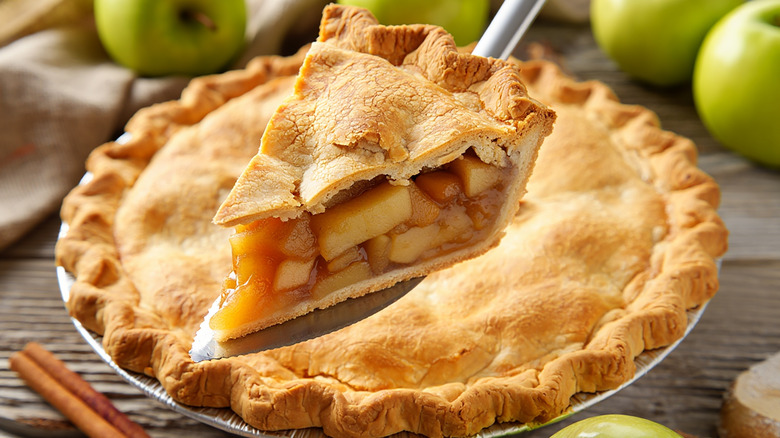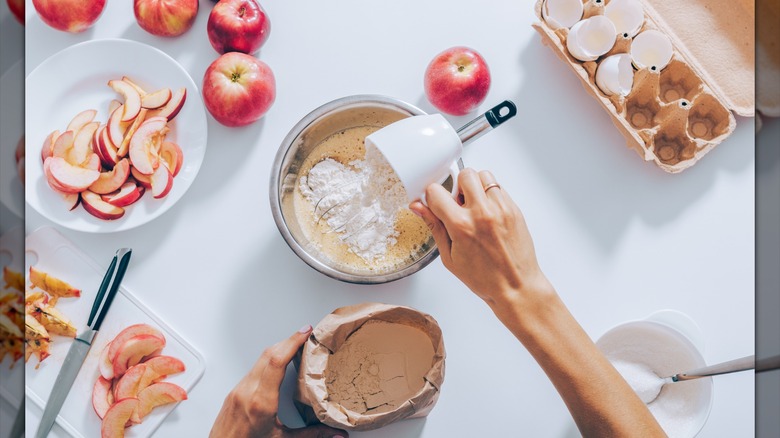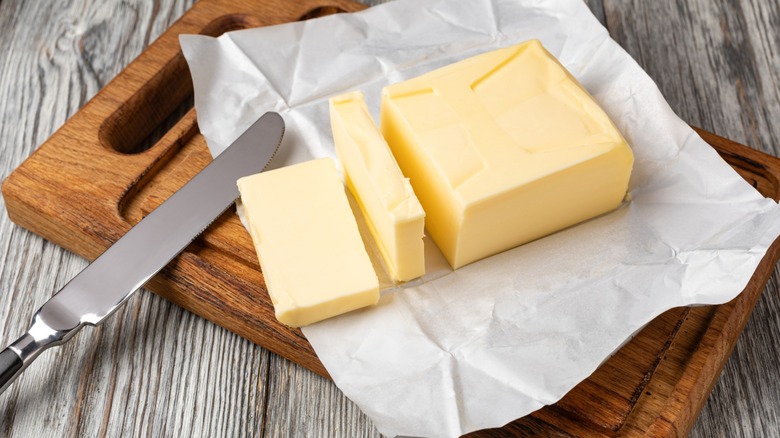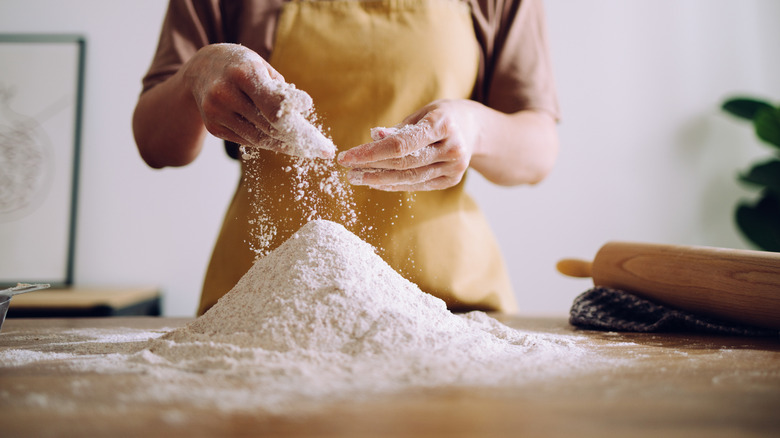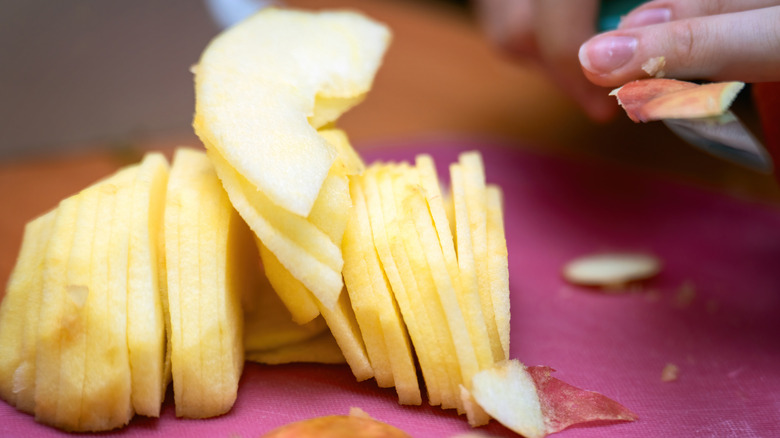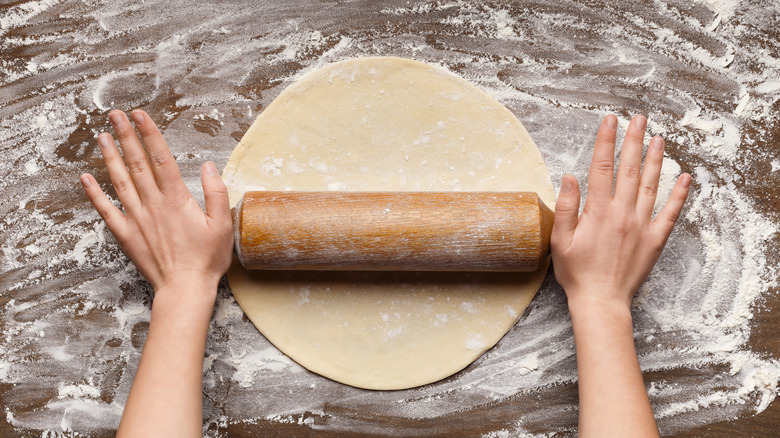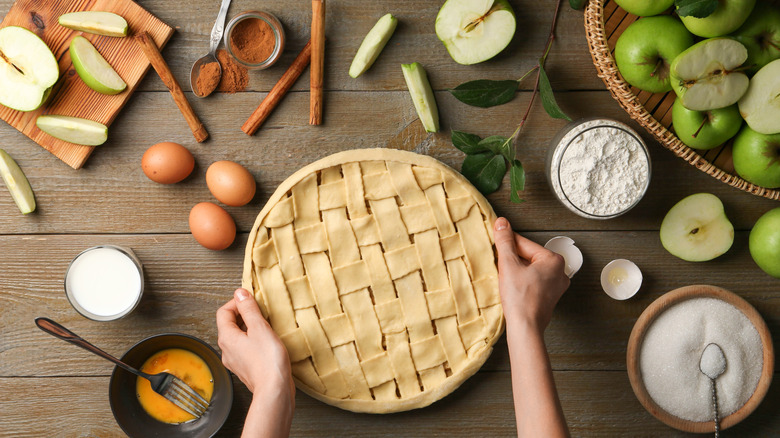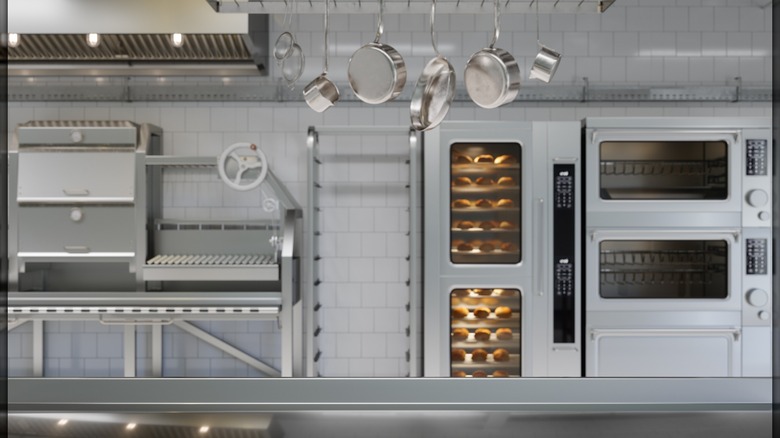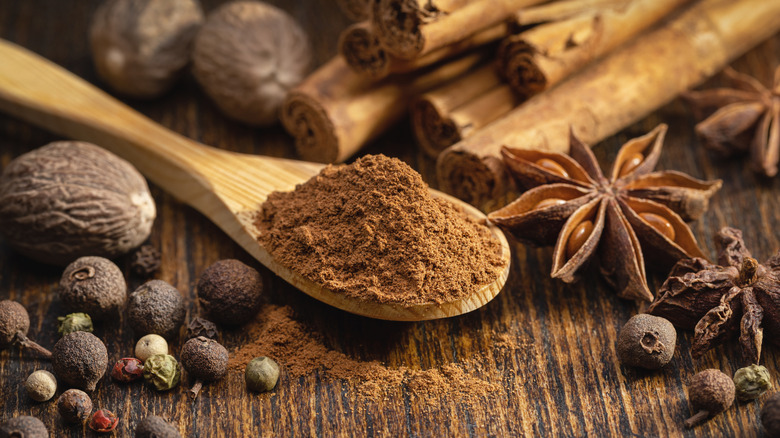Why Apple Pie Tastes Better From A Bakery
Baking the perfect apple pie isn't easy. You might make a decent one but it's just not the same as your favorite apple pie from that cute neighborhood bakery. If you're struggling to achieve the perfect pie, it doesn't mean you're a bad baker. Nor does it necessarily mean you're using a poor recipe. It's just that professional bakers have levels of knowledge and experience most home bakers can't dream of.
There isn't just one reason why apple pie tastes better from a bakery. Rather, there are many small variables that all add up to make a huge difference. Home bakers might not realize how much impact little things can have, from keeping your ingredients cold to choosing the right apples. Combined, they can make or break a pie.
You don't need an elaborate recipe. It's all in the details. Even when you're following a simple apple pie recipe, you can tweak things to make your finished dish bakery-worthy. Once you know how professional bakers do it, you can work with your preferred recipe and transform it into something that looks and tastes like you paid top dollar for it. Or, you might realize how much effort goes into an exceptional apple pie and decide to leave it to the pros.
Bakers think carefully about which apples to use
The average home cook is probably going to grab whatever apples they can find at the store. But, professionals think carefully about which apples to use. And therein lies the difference. You might assume that all apples will give you the same results, but that's not quite right. Some are sweeter than others. Some hold up well to cooking while others turn to mush. These factors make a big difference to the finished pie.
For some, the solution is using a combination of sweet and tart apples in a pie, or a mixture of apples that hold their shape well and ones that cook down to a more sauce-like consistency. Baker and "Great British Bake Off" judge Paul Hollywood uses a combination of cookers and eaters in his apple pie. The trouble is, dedicated cooking apples — like Bramley — are less common in the U.S.
Others in the know, however, prefer to stick to just one type of apple. Granny Smith is a favorite with many professional bakers, as its tartness balances out the sugar in the filling and the crust. However, it isn't the firmest apple when baked. Golden Delicious has a great balance of a firm texture when baked and a sweet apple flavor. Braeburns also have a good balance of texture and flavor. Ultimately, what great bakers do is experiment until they get it right, so you might need to try a few duds before you find the right fit.
Professionals know how important it is to keep pie crust ingredients cold
Yes, the apples are important, but the pie crust matters, too. No matter how perfectly you make the filling, you'll never make a perfect, bakery-quality apple pie without getting the pastry right. And one tip that professional bakers live by is always keeping the pie crust ingredients cold. It's what gives the crust a flaky finish. It might take a bit more effort, but it's worth the extra time it takes.
Ideally, little chunks of flour, or butter-flour paste, in the dough should melt in the oven, not before. This makes the crust come out with flaky layers. If the butter melts before it hits the oven, it just incorporates into the dough, and you get something that's more like a firm shortbread.
So, to keep the butter from melting too early, it's important to keep the ingredients cold. Use butter that's straight out of the fridge and make sure the water that goes in the recipe is ice cold. If it's a particularly hot day, you can also chill the flour in the fridge. It sounds odd, but it does make a difference. Professional bakers have their own techniques for keeping everything cold, and that's part of what makes their pie crusts so good.
Your favorite bakery pie may have an all-butter crust
There are some unusual ways celebrity chefs upgrade apple pie, from adding cheese to the crust to caramelizing the apples. But you don't really need anything fancy to make a great apple pie; just good quality ingredients. And one big difference you'll often notice is the flavor of the crust. This might be because your favorite apple pie from a bakery has an all-butter crust.
Flavor is the main reason to use just butter in your recipe. Shortening and lard can be easier to work with, but they don't taste like much. They also have higher melting points, which means it's easier to achieve the flake you want from a pie crust. Sometimes bakeries may use a combination of butter and shortening, but because professionals have the technical skill, they can often pull off an all-butter crust, getting maximum flavor and a great flake.
Using the right type of butter is important, too. Most U.S. apple pie recipes will be tested and perfected using American butter. You might think the European stuff looks fancier, but they have a higher percentage of fat, which can be a problem in recipes developed for American butter. It can leave the dough soft and make it hard to get a flaky texture in the crust.
In bakeries, pie crusts are made with a careful choice of flour
To make the perfect pie crust, you need just the right amount of gluten development. That's why, in bakeries, the crust will be made with a carefully chosen flour variety, whereas home bakers often use whatever they have on hand. Too much gluten in the flour, and the crust will come out tough, rather than tender. Too little, and the raw dough is prone to falling apart and there may not be enough gluten development to form a flaky texture.
But, you might be wondering how you can even tell how much gluten is in your flour. It's very simple: just look at the protein content on the package. The protein percentage is the same as the percentage of gluten. All-purpose flours can range anywhere from around 8% to 12% protein. This might not look like a huge gap on paper, but in practice, just a few percentage points gives you a very different dough texture. Somewhere around 10% protein is the sweet spot for a killer pie crust.
Professional bakers are careful not to overmix or overwork the dough
Now you know that gluten development is important in a pie crust. You don't want too much or too little of it. One of the ways that you can form too much gluten is from overmixing or overworking the dough, so professional bakers are careful not to do this. Having made thousands of pies, they have the skills and knowledge needed to avoid making the crust tough from overworking, whereas this is a common mistake home bakers make.
If you make bread, you'll know that gluten development is what you want to give a loaf structure. But, when making an apple pie, you should keep that development to a minimum. While there is such a thing as too little gluten development, it's far more common to overdo it. Generally, it's better to mix it too little rather than too much. If you think you're mixing it too little, you're probably doing it just the right amount.
If you don't feel confident about making pastry from scratch, there are ways to upgrade store-bought pie crust. But, ultimately, you'll often get much better results by making the pastry yourself. Okay, if you really mess it up, then you might have been better off with a store-bought crust, but if you follow the recipe carefully, pastry isn't a terribly difficult thing to make.
The apples in bakery pies may be parcooked before baking
If you're wondering how your favorite apple pie from a bakery manages to get its apples perfectly tender while still holding their shape and not turning mushy, they may have been parcooked before baking. It's one of the ways to get apples to have that perfect texture that many people expect from a bakery pie. Although it may seem counterintuitive that more cooking equals a firmer texture, there's science behind it.
When apples are heated to roughly 160 degrees Fahrenheit and kept at this temperature for a while, the pectin in apples becomes more heat stable. This means that when the apples are subsequently cooked in a pie, they stay more firm. The other benefit to this is that the apples lose less moisture during their baking time, so you don't end up with a pie that has a soggy bottom.
If this sounds like way too much effort, you might be pleased to know it's actually way less difficult than it sounds. All you need to do is pour boiling water over your sliced apples and leave them for about 10 minutes. After this, drain them, dry them with a clean kitchen towel, and use them in your recipe as usual.
Professional bakers adjust for environmental factors
Baking can be finicky. You make a recipe one day and it turns out perfectly. Try it again the next and it's a total flop. Environmental factors make more of a difference than many people account for. But, with their skills and experience, professional bakers know how to adjust for them.
Heat and humidity are the biggest issues with making pie dough. We've talked about how important it is to keep the butter in the crust from melting before the pie hits the oven. Well, that's even tougher on a hot day or in humid conditions. Bakers know this and will account for it, chilling ingredients for longer or putting the dough in the fridge when they're not actively working it.
Professionals are also likely to have equipment to counteract this. They may use food processors to make the dough, as this limits heat transfer compared to working the dough by hand. Some professional kitchens also use marble slabs to keep the dough cool. If you don't know how to adjust for environmental factors, there's a chance your apple pie recipe just won't turn out the way it should.
Bakeries have ingredients that are tougher for home bakers to purchase
If you're wondering the real reason your apple pie is too wet, you might be lacking some of the specialist ingredients that commercial bakeries are able to acquire. They aren't necessarily impossible for home bakers to find but you might not get them in every grocery store. And some you'd have to buy from specialist suppliers.
One such ingredient that is hard to find is Instant ClearJel. It's a type of modified cornstarch that effectively thickens pie fillings. While you can use regular cornstarch or even flour, it doesn't have quite the same thickening power and you're more likely to end up with excess liquid and a soggy pie crust. There are also professional quality pie filling enhancers for thickening and preserving. The use of these professional ingredients may be what sets your bakery favorite apart from homemade pies.
Professional bakers pay extra attention to ingredient quality
Most people who bake for a living do so because they love it. They're certainly not in it for the money or the sociable hours. The ingredient quality of a bakery pie may be higher because professional bakers care. They want to make the best apple pies possible and they use their baking knowledge to pick out the ingredients that will give them the results they want.
Professional bakers might use locally sourced and milled flour that helps give the crust the perfect flaky texture. Or perhaps they have a contact at a nearby orchard that grows apples that have a great flavor and hold up well to baking. They might have tried 10 different brands of butter to find the one that tastes and performs the best. By contrast, even if you picked out higher-end ingredients at the grocery store rather than the cheapest of everything, it's unlikely the same level of thought went into it.
So, when you buy an apple pie from a bakery, you're not just tasting the skill and experience of the baker, but you're benefitting from their ingredient knowledge. Not to mention the fact that they've likely trialed different ingredients over the years to find the best. Sure, you can gain this knowledge for yourself over time, but it isn't as simple as chilling your butter or looking at the gluten content of your flour.
The ovens in commercial bakeries perform differently
Unless it's a small cottage operation, bakeries tend to use commercial ovens. These perform differently from home ovens, so if you're not achieving the results you were hoping for, this could be part of the reason why. Made for reliably baking goods to perfection, even a decent home oven can't quite match up.
Bakeries tend to use convection ovens or deck ovens. Commercial convection ovens circulate hot air around the oven. This prevents hot spots and cold spots from forming, an issue that's common in home ovens, and leads to more uniform baking. That impeccably browned crust on your bakery favorite might be down to the type of oven used.
Then you have deck ovens, which have hot stones to help evenly distribute heat. They're also able to circulate steam, so they're particularly popular for bread baking, but they work well for pies, too. The hot stone can prevent pie crust from ending up soggy underneath.
Short of buying a commercial oven, there's not much you can do about this difference. However, if you're getting uneven results, keep an eye on your pie while it's baking and rotate the dish as necessary, so you don't get some parts overdone and others underbaked.
Bakeries have in-house apple pie spice blends and know how to use them
When you buy an apple pie from a bakery, it's likely made with the bakery's own spice blend. Although most apple pies contain a similar blend of spices, even small differences in the ratio have an impact. And that can be what makes you love one apple pie and think another similar one is just okay. For many bakeries, these spice blends are closely guarded secrets, so it can be hard to precisely replicate your pie of choice.
Apple pie spice is often heavy on the cinnamon, with a little bit of nutmeg and allspice added. But, there are variations. Some bakeries might add some cardamom for a hit of fruitiness and menthol. Others like the warmth of ginger in the mix. Then, you'll have others that go minimalist and add nothing but cinnamon. You may need to experiment until you get it right.
The other difference is that, through trial and error, professional bakers have learned just the right amount to use to complement the apples without overwhelming them. Spices are delicious, so there's a tendency to be heavy-handed, but you really want the apple to be at the forefront, with just a touch of spice. That said, too little spice can make the filling disappointing, so finding that balance is essential.
Apple pie from a bakery has a chance to rest before being served
We know the temptation of wanting to slice right into an apple pie as soon as it's fresh out of the oven. But, bakery apple pies have a chance to rest, and it makes more difference than you might imagine. So, if you can exercise restraint, it will pay off.
A warm pie sounds delicious, but the texture of both the filling and crust is best at room temperature. If you cut into a pie too soon, the filling won't be set, so it will run everywhere. All the effort you put into finding the perfect starch for thickening and choosing the apples with the best texture will have been for nothing. A room temperature pie crust is also flakier than one straight out of the oven. So, if you can wait for a couple of hours before you slice into your pie, it'll be at its best.
